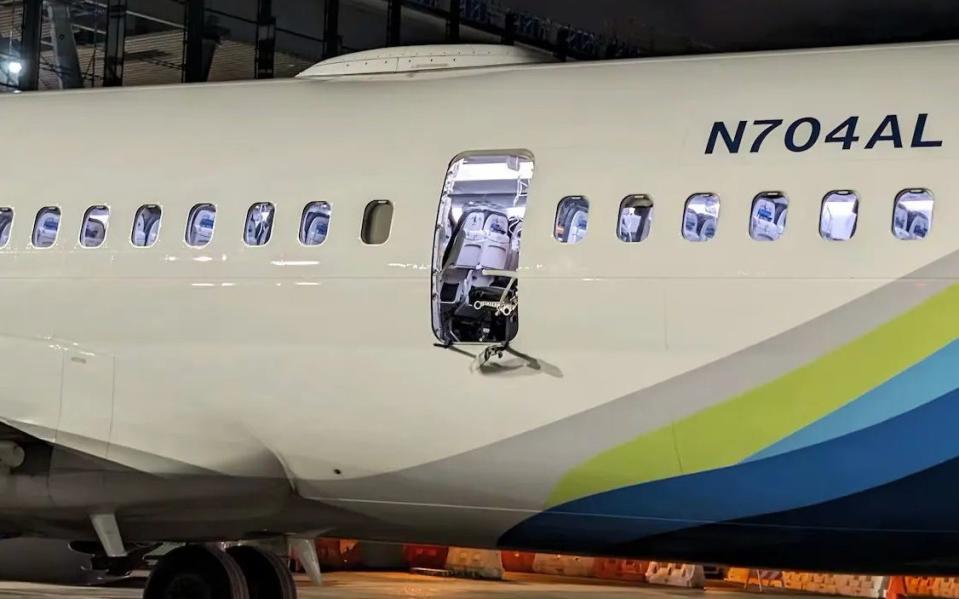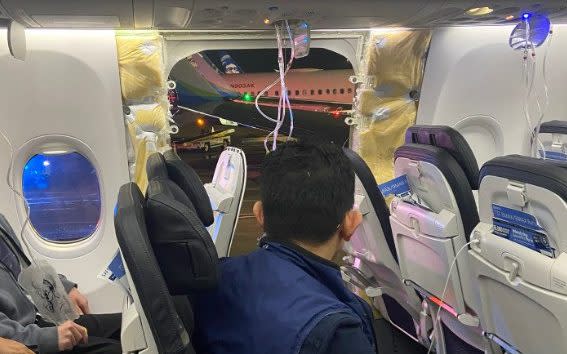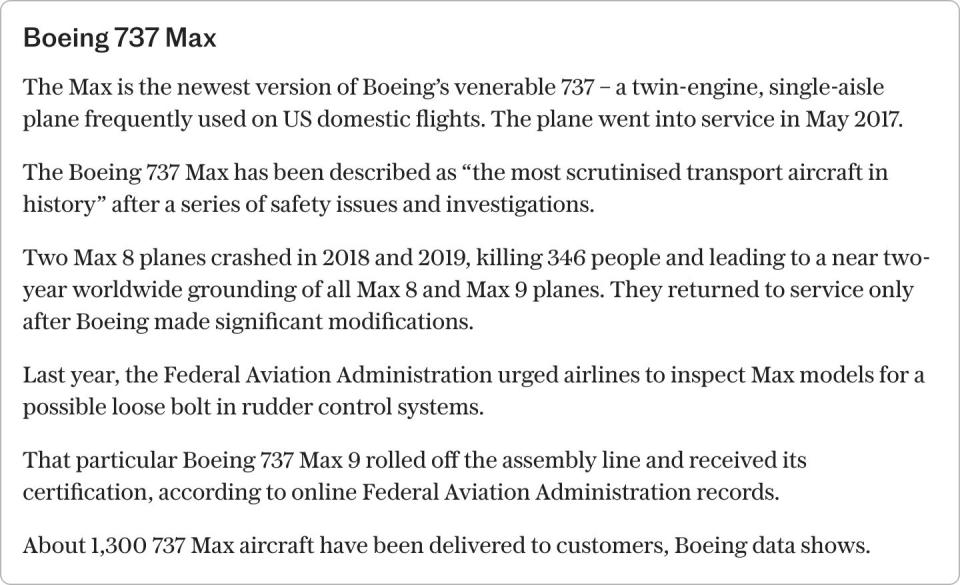More than 170 Boeing passenger jets have been grounded after a refrigerator-sized hole opened in a plane mid-flight.
Phones, magazines and even the shirt off a child’s back were pulled from an Alaska Airlines service from Oregon to California on Friday, sparking concern about the Boeing 737 Max 9 plane used by commercial airlines around the world.
171 planes operated in the US are grounded by the US Federal Aviation Administration (FAA) and officials conduct safety checks. The British Civil Aviation Authority (CAA) has demanded that all planes of the same model be inspected before entering UK airspace.
There is a risk of consequential delays and travel chaos in the coming days due to the grounding of hundreds of aircraft, mainly used for domestic American flights.

Preliminary investigations on Saturday indicated that the faulty part of the plane was a deactivated emergency door that had been built into the aircraft, but was not in use at the time.
Passengers said their phones and other loose items were ripped from their hands as the cabin suffered an “explosive” decompression and was forced to return to Portland for an emergency landing.
One toddler sitting next to the hole had his shirt off his back as his mother tried to stop him from being pulled out of the plane cabin.
A passenger said the boy appeared to have lost his shirt, and his skin looked red and irritated. Flight attendants reportedly helped the mother and son move to the other side of the plane a few minutes later.
In the distress call to air traffic control, a woman is heard saying: “We’re in an emergency. We are pushed out, we have to get back.”
The pilots made the emergency landing 35 minutes after take off, and about 15 minutes after the part of the plane separated.
Emma Vu, a passenger on the flight, later sent her text messages to her family members on TikTok.
She wrote: “I’m so scared right now. Please pray for me,” added: “Please, I don’t want to die.”
Evan Smith, another passenger, told reporters: “There was a very loud bang towards the left rear of the plane and a woosh noise – and all the air masks fell off.
“They said there was a child in that row who [had] His shirt pulled him off the plane and his mother was holding him to make sure he didn’t go with it.”
Diego Murillo, who was also on the flight, said the gap was “as wide as a refrigerator,” while another, Elizabeth Lee, described the deafening noise as a powerful gust of wind through the cabin.
“Part of the plane was missing and the wind was really loud,” said the 20-year-old. “It was honestly horrible.”
She added that the howling wind meant that announcements made over the speaker system were inaudible.
No serious injuries were initially reported among the 171 passengers and six crew members. One flight attendant was reported to have sustained minor injuries.


The airline gave passengers who experienced the ordeal a complimentary flight with more legroom, and free drinks and snacks.
Alaska Airlines has grounded 65 Boeing 737 Max 9 aircraft for testing, to ensure the crash does not happen again on any of its other services.
Ben Minicucci, the company’s chief executive, said: “All aircraft will only be returned to service after full maintenance and safety inspections have been completed.”
“My heart goes out to those who were on this flight – I am very sorry for your experience,” he said.
Boeing said it was aware of the incident and is “working to gather more information”.
“The FAA requires immediate inspections of certain Boeing 737 Max 9 airplanes before they can return to flight,” said FAA administrator Mike Whitaker.
United Airlines also said Saturday it had temporarily suspended service on all Boeing 737 MAX 9 aircraft to conduct inspections required by the FAA.
Meanwhile, the CAA said there are no Boeing 737 Max 9 planes registered in the UK and the impact on British travelers is therefore likely to be “minimal”.
Only in service for a month
A spokesman for the company said: “We have written to all non-UK and foreign license carriers to request confirmation that inspections have been carried out before any operation in UK airspace.”
China’s aviation regulator said it is launching an emergency meeting to consider a response to the incident, including the possible grounding of the Boeing Max fleet in the country.
Images show the hole that opened up was in the rear third of the plane, behind the wing, where the aircraft sometimes has an emergency exit.
Alaska Airlines chose not to configure its plane with an emergency door, and the panel that covered the hole in the fuselage appears to have been ripped off.
The plane was only in service for a month, after being certified in October, according to FAA records.
The incident comes less than three months after Alaska Airlines attempted to hijack an off-duty pilot who appeared to be suffering a psychotic episode.
Joseph Emerson, 44, later said he was under the influence of psychedelic mushrooms when he tried to cut the plane’s engines and open the emergency exit, believing he was in a dream.
The Max is the newest version of Boeing’s 737 – a twin-engine, single-aisle plane often used on US domestic flights. The aircraft entered service in May 2017.
The model was described as “the most scrutinized transport aircraft of all time” following a series of safety issues and investigations.
Ongoing controversy
Two Max 8 planes crashed in 2018 and 2019, killing 346 people and leading to a nearly two-year worldwide grounding of all Max 8 and Max 9 planes. They only returned to service after Boeing made significant modifications to do.
About 1,300 737 Max aircraft have been delivered to customers, Boeing data shows, and are primarily used in the United States by Alaska Airlines and United.
The FAA said its inspection of the domestic fleet of 737 Max 9 planes would take four to eight hours per aircraft.
By Saturday afternoon, Alaska Airlines said it had already begun clearing some of its fleet for takeoff, after safety inspections came back clear.
Other international operators using the plane include Copa, Aeromexico, Turkish Airlines and Icelandair.
A Boeing spokesman said: “Safety is our number one priority and we regret the impact this incident has had on our customers and their passengers.
“I agree with and fully support the FAA’s decision to require an immediate inspection of 737-9 airplanes with the same configuration as the affected airplane.
“Additionally, Boeing’s technical team is supporting the National Transportation Safety Board’s investigation into last night’s incident. We will remain in close contact with our regulator and our customers.”
Seat belt key to survival
The Alaska Airlines incident could have been much worse if passengers had not been wearing their seat belts or had not secured their oxygen masks quickly, according to experts.
The jet reached 16,000 feet when a chunk, known as a “refrigerator”, ripped out.
Anthony Brickhouse, an air safety expert at Embry-Riddle Aeronautical University, said: “This is a very serious situation, and it could have been much worse.”
He said the incident highlights the importance of passengers keeping their seat belts fastened while seated in an aircraft, even if the fasten seat belt light is off.
“If someone had been sitting in that seat and they hadn’t been seated, it would have been a different situation.”
In previous incidents, passengers have tragically died after being completely or partially pulled out of broken windows. In 2018, Jennifer Riordan died after being partially ejected from a window on a Southwest Airlines plane hit by debris from a blown engine at an altitude of 32,000 feet.
Passengers are also encouraged to secure oxygen masks quickly if their aircraft is damaged.
Professor Graham Braithwaite, a flight safety expert at Cranfield University, said: “It seems to have happened quickly. In this case, the aircraft will eject very quickly; The air will run out, there might be fog in the cabin, and definitely a loud noise.
“It will be quite dramatic and scary for passengers.”
The incident would have been more severe if it had occurred at cruising altitude, he said.
The depressurisation is stronger at higher altitudes; for example, if the plane is cruising between 30,000 to 35,000 feet, and it can be more extreme on smaller flights. The greater the damage to the aircraft structure, the faster the rate of decompression.


Professor Braithwaite said: “This one was at 16,000ft, and the pressure in the cabin would be between 8,000 and 10,000ft, so the pressure difference wouldn’t be as great as it would be at 30,000 to 35,000 feet.
“On the flight deck, they’re going to want to descend quickly to get the aircraft down to 10,000 feet, which is where people can normally breathe.”
Oxygen masks at high altitude are essential to avoid hypoxia. Hypoxia is a state caused by low levels of oxygen in the arterial blood, causing confusion and difficulty breathing, and if sustained, can lead to brain damage.
He said: “When decompression occurs, it is vital that everyone on board is fitted with an oxygen mask. The risk of developing hypoxia occurs quickly, which prevents people from thinking logically.”
The temperature also drops as the cabin temperature equals the outside air. In addition, the air blows through the cabin, and fog or mist can descend from the change in humidity.
Debris and unsecured items can fly around the cabin or be ejected from the aircraft, and dust can limit visibility.
Airline staff encourage passengers to remain calm and not remove loose personal items from bags or seat pockets. They may also instruct passengers to sit in the barrier and protect their heads from loose items.